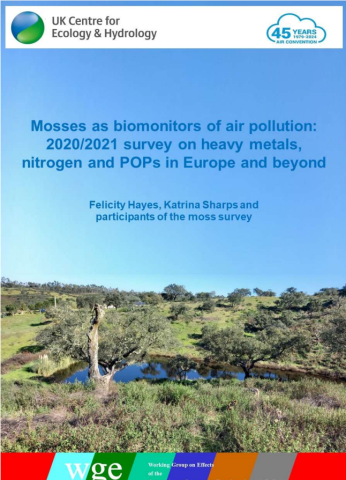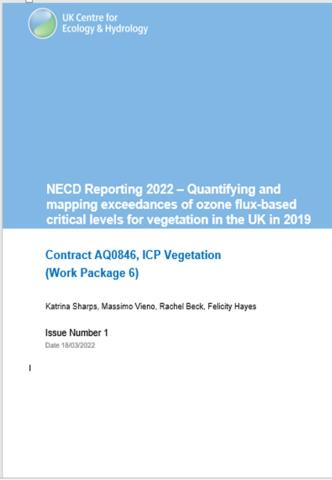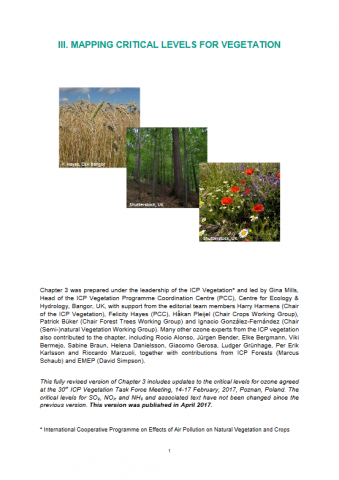Heavy metals are emitted from a variety of sources, including the metals industry, other manufacturing industries, electricity and heat production and road transportation. Heavy metals are harmful to human health and the environment, and can accumulate in soils and food chains (e.g. accumulation in crops and mercury accumulation in fish).
European surveys of heavy metal accumulation in mosses
The idea of using mosses to measure atmospheric heavy metal deposition was developed in the late 1960s. It is based on the fact that mosses, especially the carpet-forming species, obtain most of their nutrients directly from precipitation and dry deposition; there is little uptake of metals from the soil. Heavy metals deposited from the atmosphere tend to be retained by the mosses thereby making sampling and chemical analysis more robust. It is easier and cheaper than conventional precipitation analysis as it avoids the need for deploying large numbers of precipitation collectors with an associated long-term programme of routine sample collection and analysis.
The heavy metals in mosses survey was originally established in 1980 as a Swedish initiative under the leadership of Åke Rühling. The first European scale survey was carried out in 1990, and the number of participating countries has expanded greatly since then. Twenty five countries took part in the 2010/11 survey, collecting moss from >4,500 sites. During 2001, responsibility for the coordination of the project was handed over from the Nordic Council of Ministers to the ICP Vegetation Programme Coordination Centre at CEH Bangor. In 2014, coordination of the survey was transferred to the Joint Institute for Nuclear Research in Dubna, Russian Federation, and is now led by Dr Marina Frontasyeva. Surveys are conducted every 5 years. The results and report for the 2015/16 survey will be available by the end of 2018. Thirty four countries have submitted data for the 2015/16 survey and participation has largely extended in Eastern Europe and Central Asia.
The most recently published report (2010/11 survey) showed that the lowest metal concentrations were generally found in Northern Europe, whilst the higher metal concentrations were recorded in South-Eastern Europe. A north-west to south-east gradient was seen for many metals, particularly for metals associated with wind-blown dust, for example aluminium and iron. However, metal-specific spatial trends were also found, for example, the zinc concentrations in mosses had a homogenous distribution across Europe, with local areas of elevated concentrations. Further details are available in Data and Maps.
The most recent moss survey was conducted in 2015/16 and coordinated by the Moss Survey Coordination Centre at JINR, Dubna, Russian Federation. The report is expected to be published early 2019. Participation in the 2015/16 survey has particularly increased in Eastern Europe, the Caucasus and Central Asia (EECCA region). The table below provides on overview of countries that have submitted data on heavy metals (all), nitrogen and persistent organic pollutants .
Countries that have submitted data on heavy metals (all), nitrogen (N) and persistent organic pollutants (POPs) in the 2015/16 moss survey.
1 South-Eastern Europe; 2 Eastern Europe, the Caucasus and Central Asia.
Decline in heavy metal concentrations in mosses (1990 – 2010)
Averaged across Europe, the median heavy metal concentration in mosses has declined (although not significantly for all metals). The decline was 77% for lead (due to the introduction of unleaded petrol), 55% for vanadium, 51% for cadmium, 43% for chromium, 34% for zinc, 33% for nickel, 27% for iron, 21% for arsenic (since 1995), 14% for mercury (since 1995) and 11% for copper. For cadmium and lead, the decline was similar to those reported for EMEP modelled deposition across Europe (74 and 51% respectively). The 14% decline for mercury between 1995 and 2010 in mosses was lower than the decline in the deposition value reported by EMEP (27%).
In recent decades, emission sources in Europe have become cleaner and some high polluting local emission sources have been shut down. However, long-range transboundary transport still contributes to metal deposition in the majority of European countries. Therefore, both regional and global actions are required to reduce heavy metal pollution, particularly for metals such as mercury. Hence in 2013, the Minamata Convention was established.
Summary
- Moss sampling provides a cost-effective alternative for deposition monitoring to assess i) spatial patterns and temporal trends of heavy metal deposition, and ii) effectiveness of heavy metal pollution abatement policies;
- Since 1990, heavy metal pollution has been declining in Europe and therefore also their concentrations in naturally growing mosses (up to 77% for lead);
- However, hotspots of heavy metal pollution and concentrations in mosses remain, especially in (South)-Eastern Europe.



